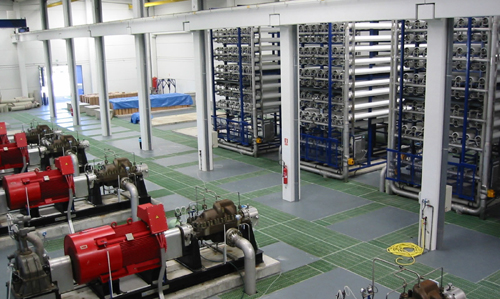[미국] 중국과학원, 해수담수화를 위한 초고수 유속 막 개발
상하이고등연구소 및 상하이대 공동 연구팀, 그래프다인 복합막 개발
해수담수화에서 거의 완벽한 염 거부 반응과 초고수 유속을 달성
국제 과학 학술지 『네이처워터(Nature Water)』 9월 4일자에 게재

중국과학원 상하이고등연구소(SARI) 쩡가오펑(ZENG Gaofeng) 교수가 이끄는 연구그룹은 상하이대학교 쉬궈성(SHI Guosheng) 교수와 공동으로 그래프다인 복합막을 개발해 해수담수화에서 거의 완벽한 염 거부 반응과 초고수 유속을 달성했다.
깨끗한 물의 수요와 공급 불균형은 글로벌 지속가능성 위기를 초래한다. ‘유엔 세계 물 개발 보고서 2023(United Nations World Water Developments Report 2023)’는 20∼30억 명의 인구가 물부족으로 고통받고 있다고 밝혔다.
막 분리를 통한 해수 담수화를 통해 깨끗한 물로 변환하는 것은 유망한 접근 방식을 제공한다. 그러나 대부분의 막은 가혹한 조건 또는 복잡한 제조 공정으로 인해 막 품질이 저하되어 물 생산성, 에너지 효율성 및 막 사용이 낮아지기 때문에 낮은 물 흐름으로 인해 제한된다. 따라서 높은 유속을 갖는 담수화 분리막의 개발이 필수적이다.
최근 중국과학원(Chinese Academy of Sciences) 상하이고등연구소(Shanghai Advanced Research Institute, SARI) 쩡가오펑(ZENG Gaofeng) 교수가 이끄는 연구그룹은 상하이대학교(Shanghai University) 쉬궈성(SHI Guosheng) 교수와 공동으로 그래프다인 복합막을 개발해 해수담수화에서 거의 완벽한 염 거부 반응과 초고수 유속을 달성했다.
이번 연구 결과는 국제 과학 학술지 『네이처워터(Nature Water)』 9월 4일자에 게재됐다.
연구진은 온화한 용매열 조건에서 글레이저-헤이(Glaser-Hay) 교차 결합 반응을 통해 헥사에티닐벤젠(hexaethynylbenzene) 단량체로부터 직접 다공성 Cu 중공 섬유에 초미세한(submicron) 두께의 나노기공(nanopore) 구조의 그래프다인 막(graphdiyne membrane)을 제작했다.
그래프다인 막(graphdiyne membrane)은 해수의 작은 이온에 대해 99.9% 이상의 거부율을 나타냈고, 제올라이트 막(zeolite membrane), 금속-유기 골격 막(metal-organic frameworks membrane) 및 그래핀 기반 막(graphene-based membrane)과 같은 상업용 막보다 1∼3배 더 높은 물 흐름을 나타냈다.
또한 고염수, 실제 해수, 오염물질 함유수를 대상으로 한 장기 테스트에서도 신뢰할 수 있는 안정성을 보였다.
이론적 계산에 따르면 염수-물(saline-water) / 그래프다인(graphdiyne) 및 염수-물( saline-water) / 증기의 경계면에는 염이 없는 순수한 물의 1∼3개 분자층이 포함되어 있어 그래프다인 막에서 완전한 염 제거에 기여하는 것으로 나타났다.
2층 그래프다인 채널 모델(two-layered graphdiyne channel model)을 통해 초고수속(ultrahigh water fluxes)이 달성되었으며 이는 실험적 관찰과 일치한다.
이러한 발견은 그래프다인 막(graphdiyne membrane)을 제조하기 위한 적응형 방법을 제공할 뿐만 아니라 유사한 방법으로 막 분리, 이온 전달 및 에너지 전환에 사용될 수 있는 다른 알카다인(alkadiyne) 함유 막을 얻을 수 있는 가능성을 나타낸다.
『네이처워터(Nature Water)』 9월 4일자에 개제된 이 연구논문의 초록(abstract)은 다음과 같다.
막 담수화는 염분이 있는 물에서 담수를 생산할 가능성을 보여주는 새로운 기술이다.
그러나 대부분의 막은 낮은 담수 유량으로 인해 물 생산성, 에너지 효율 및 막 사용량에 영향을 미친다.
여기서 우리는 다공성 Cu 중공 섬유 상의 서브마이크로미터 두께 및 나노포어 구조의 그래프다인 막을 제시한다.
우리는 3.5 wt% NaCl 용액의 진공 막 증류에서 상용 고분자 막보다 약 1∼3배 높은 ∼700 lm-² h-¹에 이르는 거의 완벽한 NaCl 거부(99.9%)와 초고수 투과율을 달성한다.
막 안정성은 초염수, 실제 해수 및 오염물질이 함유된 물을 공급함으로써 입증된다.
막의 결과적인 계면 및 미세 구조적 특성은 계면 이온 체액 효과와 증기 수송 능력을 결합하여 완전한 염분 배제를 가능하게 하고 물 흐름을 가속화한다.
실험적이고 이론적인 연구들은 그래프다인 층간 사이의 계면 수송이 층간 기공을 통한 수송에 비해 몇 배나 큰 폭으로 물의 흐름을 증가시킨다는 것을 밝혀냈다.
[원문보기]
Researchers Develop Ultrahigh-water-flux Membranes for Seawater Desalination
The supply-demand imbalance of clean water results in global sustainability crisis. The United Nations World Water Developments Report 2023 reveals that 2-3 billion populations are suffering from water shortage.
Seawater desalination via membrane separation to clean water offers a promising approach.
However, most membranes are restricted by the low water flux because membrane quality is challenged by harsh conditions and/or complex processes in preparation, leading to low water productivity, energy efficiency and membrane usage. Thus, it is essential to develop desalination membranes with high flux.
Recently, a research group led by Prof. ZENG Gaofeng at Shanghai Advanced Research Institute (SARI) of the Chinese Academy of Sciences, in collaboration with Prof. SHI Guosheng at Shanghai University, has developed graphdiyne composite membranes and achieved nearly complete salt rejections and ultrahigh water flux in seawater desalination.
The results were published in Nature Water on Sept. 4.
The researchers fabricated nanopore-structured graphdiyne membranes with thickness of submicron on porous Cu hollow fibers directly from monomer of hexaethynylbenzene via Glaser-Hay cross-coupling reaction under mild solvothermal conditions.
The graphdiyne membranes exhibited over 99.9% rejections to small ions of seawater and 1-3 orders of magnitude higher water fluxes than commercial membranes, such as zeolite membranes, metal-organic frameworks membranes and graphene-based membranes. They also exhibited reliable stability in the long-term tests with hypersaline water, real seawater and pollutant-containing waters.
Theoretical calculations suggested that interfaces of saline-water/graphdiyne and saline-water/vapor contained 1-3 molecular layers of pure water without salt, which contributed to complete salt rejections on graphdiyne membrane. Through a two-layered graphdiyne channel model, ultrahigh water fluxes were achieved, which is in line with experimental observations.
These findings not only provide an adaptive method for preparing graphdiyne membranes but also indicate the potential of obtaining other alkadiyne containing membranes under similar methodology, which may be used for membrane separation, ions transfer and energy conversion.
Abstract
Membrane desalination is an emerging technology that shows promise for producing freshwater from saline waters.
However, most membranes are challenged by low freshwater flux, impacting the water productivity, energy efficiency and membrane usage.
Here we present the submicrometre-thick and nanopore-structured graphdiyne membranes on porous Cu hollow fibres.
We accomplish nearly perfect NaCl rejections (>99.9%) and ultrahigh water permeabilities reaching ~700 lm -2 h -1, which are approximately 1∼3 orders of magnitude higher than those of commercial polymeric membranes, in vacuum membrane distillation of a 3.5 wt% NaCl solution.
Membrane stability is demonstrated by feeding hypersaline waters, real seawater and pollutant-containing waters.
The resultant interfacial and microstructural properties of the membranes combine the interfacial ion sieving effect with vapour-transport capability to enable complete salt exclusion and accelerate the water flux.
Experimental and theoretical studies have revealed that interfacial transport between graphdiyne interlayers increases the water flux by orders of magnitude relative to transport through intralayer pores.
[출처= 중국과학원(Chinese Academy of Sciences)(https://english.cas.cn/newsroom/research_news/chem/202309/t20230904_335628.shtml) / 2023년 9월 5일]
[연구논문 출처 = 『네이처워터(Nature Water)』 (https://www.nature.com/articles/s44221-023-00123-3) / 9월 4일]



































